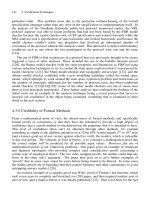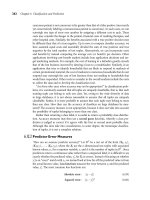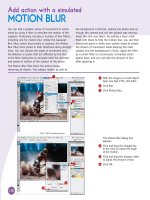presentation zen Simple ideas on presentation design and delivery phần 6 ppt
Bạn đang xem bản rút gọn của tài liệu. Xem và tải ngay bản đầy đủ của tài liệu tại đây (1.05 MB, 24 trang )
By stripping down an image to
essential meaning, an artist can
amplify that meaning
-Scott McCloud
112 Presentation Zen
Amplification Through
Simplification
The Japanese Zen arts teach us that it is possible to express great beauty and
convey powerful messages through simplification. Zen may not verbalize
"amplification through simplification," but you can see this idea everywhere
in the Zen-inspired arts. There is a style of Japanese painting called the "one-
corner" style, for example, which goes back some 800 years and is derived from
concepts of wabi and sabi. Paintings in this style are very simple and contain much
empty space. You may have a painting depicting a large ocean scene and empty
sky, for example. In the corner, there is a small, old fishing canoe, hardly visible. It's
the smallness and placement of the canoe that gives vastness to the ocean and
evokes at once a feeling of calm and an empathy for the aloneness the fisherman
faces. Such visuals have few elements, yet can be
profoundly evocative.
Learning From the Art of Comics
We can learn about simplicity as it relates to presentation visuals from unexpected
places, including—and this may surprise you—the art of comics. And the best place
to learn about the art of comics is from Scott McCloud's Understanding Comics: The
Invisible Art (Harper Paperbacks). In this popular book, McCloud repeatedly touches
on the idea of
"amplification through simplification." McCloud says that cartooning
is a form of amplification through simplification because the abstract images in
comics are not so much the elimination of detail as they are an effort to focus on
specific details.
A key feature of many comics is their visual simplicity. Yet, as McCloud reminds us,
while casting an eye to the wonderful world of Japanese comics, "simple style does
not necessitate simple story." Many people (outside of Japan at least) prejudge
comics by their simple lines and forms as being necessarily simplistic and base,
perhaps suitable for children and "the lazy," but not something that could possibly
have depth and intelligence. Surely such a simple style found in comics cannot be
illustrating a complex story they say.
Chapter 5 Simplicity: Why It Matters 113
However, if you visit coffee shops around Tokyo University—Japan's most elite
university you will see stacks and stacks of comics (manga) on the shelves.
There is nothing necessarily "stupid" about the genre of comics in Japan at all;
in fact, you'll find "brainiacs" in all shapes and sizes reading comics here, and
indeed around the world.
The situation today is that most people have not been exposed to the idea
of making a visual stronger by stripping it down to its essence. Less always
equals less in most people's eyes. If we apply this visual illiteracy to the world
of presentations, you can imagine the frustration that a young "enlightened"
professional must feel when her boss looks over her presentation visuals the
day before her big presentation and says, "No good. Too simple. You haven't
said anything with these slides! Where are your bullet points!? Where's the
company logo!? You're wasting space—put some data in there!" She tries to
explain that the slides are not the presentation but that she is the presentation
and that the "points" will be coming from her mouth. She tries to explain that
the slides contain a delicate balance of text and images and data designed to
play a supportive yet powerful role in helping her amplify her message. She
attempts to remind her boss that they also have strong, detailed
documentation for the client and that slides and documents are not the same.
But her boss will have none of it. The boss is not happy until the "PowerPoint
deck" looks like "normal PowerPoints," you know, the kind used by "serious
people."
114 Presentation Zen
We must do what we can to be firm, however, and remain open to the idea of
"amplification through simplification" as much as possible. I am not suggesting that
you become an artist or that you should draw your own images. Rather, I am
suggesting that you can learn a lot about how to present images and words
together by exploring the so-called "low art" of comics. In fact, although
presentation visuals were surely the farthest thing from McCloud's mind when he
wrote the book, we can learn far more about effective communication for the
conceptual age from McCloud's book than we can from many books on PowerPoint.
For example, early in the book McCloud builds a definition of comics and finally
arrives with this, a definition he admits is not written in stone:
"Juxtaposed pictorial and other images in deliberate sequence
intended
to convey information and/or to produce an aesthetic
response in the viewer."
It is easy to imagine, with some tweaking, how this could be applied to other
storytelling
media and presentation contexts as well. We do not have a good
definition for "live presentation with slides," but a great presentation may
indeed contain slides that are comprised of "juxtaposed pictorial and other
images." And great presentations certainly have elements of sequence designed
to "convey information and/or to produce an aesthetic response."
At the end of the book, McCloud gives us some simple, Zen-like wisdom. He's
talking about writers, artists, and the art of comics, but this is good advice to live by
no matter where our creative talents may lie. All that's needed," he says, " is the
desire to be heard. The will to learn. And the ability to see."
When you get right down to it, it always comes back to desire, a willingness to
learn, and the ability to really see. Many of us have the desire; it's the learning and
seeing that's the hard part. McCloud says that in order for us to understand comics,
we need to " clear our minds of all preconceived notions about comics. Only by
starting from scratch can we discover the full range of possibilities comics offer."
The same can be said for presentation design. Only by approaching presentations
and presentation design with a completely open mind can we see the options
before us. It is just a matter of seeing.
Chapter 5 Simplicity: Why It Matters 115
Redux: Simplicity Is Not Easy
Usually, we think about time in terms of "How can I save more time?" Time is a
constraint for us, but when planning a presentation, what if we took the notion of
"timesaving" and looked at it from the point of view of our audience instead of our
own personal desires to do things more quickly and save time? What if it wasn't just
about our time, but it was about their time? When I am in the audience, I appreciate
it very much when
I am in the presence of a speaker who is engaged, has done his
homework, has prepared compelling visuals which add rather than bore, and
generally makes me happy I have attended. What I hate more than anything—and I
know you do too—is the feeling I get when I realize I am at the beginning of a
wasted hour ahead of me.
Often, the approach I advocate may use more time, not less time, for you to
prepare, but the time you are saving for your audience can be huge. Again, the
question is: Is it always about saving time for ourselves? Isn't it important to save
time for others? When I save time for myself, I am pleased. But when I save time
for my audience—by not only not wasting their time but instead by sharing
something import
ant with them—I feel inspired, energized, and rewarded.
I can save time on the front end, but I may waste more time for others on the back
end. For example, if I give a completely worthless one-hour deathby-PowerPoint
presentation to an audience of 200, that equals 200 hours of wasted time. But if I
instead put in the time, say, 25-30 hours or more of planning and designing the
message, and the media, then I can give the world 200 hours of a worthwhile,
memorable experience.
Software companies advertise time-saving features, which may help us believe we
have saved time to complete a task such as preparing a presentation and
"simplified" our workday. But if time is not saved for the audience—if the audience
wastes its time because we didn't prepare well, design the visuals well, or perform
well—then what does it matter that we saved one hour in preparing our slides?
Doing things in less time sometimes does indeed feel simpler, but if it results in
wasted time and wasted opportunities later, it is hardly simple.
116 Presentation Zen
In Sum
Simplicity is powerful and leads to greater clarity, yet it is neither simple nor
easy to achieve.
Simplicity can be obtained through the careful reduction of the nonessential.
As you design slides, keep the following concepts in mind: subtlety, grace,
and understated eleg
ance.
Good designs have plenty of empty space. Think "subtract" not "add."
While simplicity is the goal, it is possible to be "too simple." Your job is to
find the balance most appropriate to your situation.
Chapter 5 Simplicity: Why It Matters 117
Presentation Design:
Principles and
Techniques
When I was an employee with Sumitomo in the mid-90s, I discovered that
Japanese business people often used the term "case-by-case" (keisu bai keisu)
when discussing details of future events or strategy. This frustrated me since I was
used to more concre
te plans and absolutes and making decisions rather quickly. I
learned, though, that context, circumstance, and a kind of "particularism" were
very important to the Japanese with whom I worked. Today, I might use Japanese
expressions like jyoukyou ni yotte (judgment depends on circumstance) or toki to
baai ni yotte (depends on time and circumstance) when discussing what techniques
or designs to use
for a particular presentation, for example. I used to think that it
depends" was a weak statement, a cop-out of sorts. Now I see that it is wise.
Without a good knowledge of the place and circumstance, and the content and
context of a presentation, it is difficult to say this is "appropriate" and that is
"inappropriate" necessarily, let alone to judge what is "good" or "bad." There are
no cookie-cutter approaches to design. Graphic design is as much art as science.
Nonetheless, there are some general guidelines that most appropriate and strong
slide designs share. There are a few basic and fundamental concepts and design
principles that if properly understood, can indeed help the average person create
presentation visuals that are far more effective. One could fill several volumes with
design principles and techniques. In this chapter, though, I'll exercise restraint and
elaborate on just a few principles along with practical examples and a few
techniques. First, let's look at what is meant by design.
Chapter 6 Presentation Design: Principles and Techniques 119
Presentation Design
A common misunderstanding about design is that it is something that comes at the
end, for example, it's the frosting and "Happy Birthday!" on a cake. But this is not
what I mean by design. For me, design does not come at the end; rather, it comes
at the beginning, right from the start. Design is necessary and a way to organize
information in a way that makes things clearer; it is also a medium for persuasion.
Design can make things easier for the viewer or the user. Design is not decoration.
If anything, design is more about subtraction than addition. Visually, we do not
want to include too much, nor do we want to exclude too much. Generally, people
err on the side of including too much visual information, which often results in
clutter and confusion. Stephen M. Kosslyn, a Harvard professor and author of Clear
and to the Point
: 8 Psychological Principles for Compelling PowerPoint
Presentations (Oxford University Press), warns against the inclusion of too much or
too little: "It migh
t be tempting to show how smart, knowledgeable, and well-
prepared you are by showering the audience with details. But if that information
doesn't really help you tell your story, and doesn't help the audience understand
your main points, then it just gets in the way. You will force the audience members
to search for the information-bearing needle in the haystack of your words and
graphics—and they will probably just give up."
In the world of design, there is more than one solution to a single problem. You
need to explore, but ultimately you need to look for the most appropriate solution
for the problem, given the context of your information. Design is about making
conscious decisions about inclusion and exclusion.
120 Presentation Zen
General Design Principles
In the following sections, I'll take you through seven interconnected design
principles that are fundamental to good slide design. The first two—Signal vs. Noise
Ratio and Picture Superiority Effect—are quite broad concepts but with practical
applications to slide design. The third Empty Space helps us look at slides in a
different way and appreciate the power of what is not included to make visual
messages stronger. The final four principles are grouped together in what I call "the
big four" of basic design principles: Contrast, Repetition, Alignment, and Proximity.
Designer and author Robin Williams also applied these four basic principles to the
art of document design in her best-selling book The Non-Designer's Design Book
(Peachpit Press). I'll show you how the principles can be applied to improving slide
design.
Chapter 6 Presentation Design: Principles and Techniques 121
Signal vs Noise Ratio
The Signal-to-Noise Ratio (SNR) is a principle borrowed from more
technical fields such as radio communications and electronic
communication in general, but the principle itself is applicable to design
and communication problems in virtually any field. For our purposes, the
SNR is the ratio of relevant to irrelevant elements or information in a slide
or other display. The goal is to have the highest signal-to-noise ratio
possible in your slides. People have a hard time coping with excessive
cognitive strain. There is simply a limit to a person's ability to process new
information efficiently and effectively. Aiming for a higher SNR is an
attempt to make things easier for people. Understanding can be hard
enough without the excessive and the nonessential bombardment by our
visuals that are supposed to be playing a supportive role.
Ensuring the highest possible signal-to-noise ratio means
communicating (designing) clearly with as little degradation to the
message as possible. Degradation to the visual message can occur in
many ways, such as with the selection of inappropriate charts, using
ambiguous labels and icons, or unnecessarily emphasizing items such as
lines, shapes, symbols, and logos that do not play a key role in support of
the message. In other words, if the item can be removed without
compromising the visual message, then strong consideration should be
given to minimizing the element or removing it altogether. For example,
lines in grids or tables can often be made quite thin, lightened, or even
removed. And footers and logos, etc. can usually be removed with good
results (assuming your company "allows" you to do so).
In
Visual Explanations: Images and Quantities, Evidence and Narrative
(Graphics Press), Edward Tufte refers to an important principle in harmony
with SNR called the
smallest effective difference." "Make all visual
distinctions as subtle as possible," says Tufte, but still clear and effective."
If the message can be designed with fewer elements, then there is no
point in using more.
OPPOSITE PAGE The slides on the left
side are the orginals. The signal-to-noise
ratio is improved in the slides on the right
by removing nonessential elements and
minimizing other elements.
122 Presentation Zen
Chapter 6 Presentation Design: Principles and Techniques 123
124 Presentation Zen
Chapter 6 Presentation Design: Principles and Techniques 125
But Is the Nonessential Always "Noise"?
It is generally true that unnecessary elements
decrease the design's efficiency and increase the
possibility of unintended consequences. But does
this mean that we must be uncompromising and
remove everything that is not absolutely
"essential" to a design? There are those who say a
minimalist approach is the most efficient. But
efficiency itself is not necessarily an absolute good
or always the ideal approach.
When it comes to the display of quantitative
information (charts, tables, graphs, etc.), I strongly
favor display designs that include the highest SNR
possible without any adornment, I use a lot of
photographic images in my presentations, so when
I do show a chart or a graph, I do not usually place
any other elements on the slide. There is nothing
wrong with placing a bar chart, for example, over
a background image (so long as there is proper
contrast or salience), but I think the data itself
(with a high SNR) can be a very powerful,
memorable graphic on its own.
With other visuals, however, you may want to
consider including or retaining elements that serve
to support the message at a more emotional level.
This may seem like a contradiction with aiming for
a high SNR, or the idea that "less is more."
However, often emotional elements matter
(sometimes a lot). Clarity should be your guiding
principle. As with all things, balance is important
and the use of emotional elements depends on
your particular circumstance, audience, and
objectives. In the end, SNR is one principle among
many to consider when creating visual
messages.
ABOVE The top slide is simple.The last
three slides have "nonessential elements"
added that make the slide more
interesting, but do not necessarily increase
clarity. Any of the designs may be
appropriate, however, depending on the
situation.
126 Presentation Zen
Chapter 6 Presentation Design: Principles and Techniques 127
A simple bar chart
without the use of
an image
The some simple data
with an image added. The
image complements the
underlining theme —save
the planet—without
getting in the way of the
chart. (Embedded
background images on
this page and opposite
page from
iStockphoto.com
.)
2-D or Not 2-D (that Is the Question)
Many of the design tools in Keynote or PowerPoint are quite useful, but the 3-D
tool, is one I could do very well without. Taking 2-D data and creating a 3-D chart
does not simplify it. The idea is that 3-D may add emotion, but when it comes to
charts and graphs, you should aim for simple, clean, and 2-D (for 2-D data). In The
Zen of Creativit
y (Ballantine Books), author John Daido Loori, commenting on
simplicity
, says that the Zen aesthetic " reflects a simplicity that allows our
attention to be drawn to that which is essential, stripping away the extra." What is
essential and what is extra is up to you to decide, but stripping away the extra ink
that 3-D charts introduce seems like a good place to start. A 3-D representation of
2-D data increases what Edward Tufte calls the "ratio of ink-to-data." While it's nice
to have a choice perhaps, 2-D charts and graphs will almost always be a better
solution. Three-dimensional charts appear less accurate and can be difficult to
comprehend. The viewing angle of the 3-D charts often makes it hard to see where
data points sit on an axis. If you do use 3-D charts, avoid extreme perspectives.
The slides below on the left are examples of 3-D effects that compromise the
display of very simple data. The slides on the right are possible improvements.
128 Presentation Zen
Who Says Your Logo Should Be on Every Slide?
"Branding" is one of the most overused and misunderstood terms in use today. Many
people confuse the myriad elements of brand identity with brand or branding. The meaning
of brand and branding goes far deeper than simply making one's logo as recognizable as
possible. If you are presenting for an organization, try removing logos from all except the
first and last slide. If you want people to learn something and remember you, then make a
good, honest presentation. The logo won't help make a sell or make a point, but the clutter
it brings does add unnecessary noise and makes the presentation visuals look like a
commercial. We don't begin every new sentence in a conversation by restating our name, so
why should you bombard people with your company logo on every slide?
Most companies with a PowerPoint template certainly insist that their employees use the
company logo on every slide. But is this good advice? Slide real estate is limited as it is, so
don't clutter it with logos and trademarks,
footers, and so on.
Here's some good advice:
"[h f you want people to understand better, then get that stuff off the screen
Clean it up and g
et it off because it/s simply making it more difficult for people to
understand what [you are] saying."
These are the words of Tom Grimes, Kansas State University Journalism professor,
speaking about
his research on the influence of on-screen clutter on understanding or
retention. He's actually talking about the overpowering visual clutter found in TV newscasts,
yet his advice is good for our live multimedia presentations as well. Over the past several
years, many TV news broadcasts have substituted "pizzazz" and "sizzle"—not to mention
conjecture, speculation, and sensationalism—for clean, clear messages. Perhaps the visual
clutter found in most TV news broadcasts has spilled over into the corporate slide
templates. One thing is for certain: if you want people to hear and understand your visual
message, the answer is not to add more clutter but to remove it all.
Chapter 6 Presentation Design: Principles and Techniques 129
A Word About Bullet Points
The "traditional way" of doing presentations with slides full of bulleted
lists has been going on for so long it is in a sense part of corporate
culture. It is simply "the way things are done." Here in Japan, for
example, young employees entering the company will be taught, at
some point, that when they do presentations with slideware they
should put a minimum amount of text in each slide. This sounds like
good advice, right? But, a "minimum" means something like six–seven
lines of abbreviated text and figures and several complete sentences.
The idea of having one or two words (or—gasp!—no words) would be
a sign of someone who did not do their homework. A series of text-
filled slides with plenty of charts or tables shows that you are a
"serious employee." Never mind that the audience can't really see the
detail in the slides well (or that the executive board does not really
understand your charts). If it looks complicated it must be "good."
I have a shelf full of presentation books in
English and Japanese. All of them say "use
a minimum of text." Most of them define
"minimum" as being anywhere from five to
eight lines of bullet points. The "1-7-7 Rule"
is advice often given to presenters (proof
that conventional wisdom is out of sync).
Here's the rub: no one can do a good
presentation with slide after slide of bullet
points. No one. Bullet points work well
when used sparingly in documents to help
readers scan content or to summarize key
points and so on. But bullet points
are usually not effective in a live talk.
128 Presentation Zen
How Many Bullets Points per Slide?
A good general guideline is to use bullet points only
very rarely and only after you have considered other
options for displaying the information in a way that
best supports your point visually. Do not let the default
bulleted lists of the software template dictate your
decision. Sometimes bullet points may be the best
choice. For example, if you are summarizing key
specifications of a new product or reviewing the steps
in a process, a clear bulleted list may be appropriate
depending on your content, objectives, and audience.
People will tire quickly, however, if several slides of
bulleted lists are shown one after another, so use them
with caution. I am not suggesting that you completely
abandon the idea of using bullet points in multimedia
presentations, but use of bullet points in slides should
be a rare exception.
TOP The blue slide above was my first attempt
to summarize the key points from Dan Pink's
book A Whole New Mind in one slide.
BOTTOM The second slide above uses about half
the text to summ
arize the key points in a more
engaging, visual way.
Chapter 6 Presentation Design: Principles and Techniques 131
Picture Superiority Effect
The picture superiority effect says that pictures are remembered better than words,
especially when people are casually exposed to the information and the exposure is
for a very limited time. When information recall is measured just after exposure to a
series of pictures or a series of words, the recall for pictures and words is about
equal. However, the picture superiority effect applies when the time after exposure
is more than 30 seconds, according to research cited in Universal Principles of
Design (Rockport Publishers). Use the picture superiority effect to improve the
recognition and re
call of key information. Use pictures and words together, and
ensure that they reinforce the same information for optimal effect," say the authors
Lidwell, Holden, and Butler. The effect is strongest when the pictures represent
common, concrete things.
You can see the picture superiority effect used widely in marketing
communications, such as posters, billboards, brochures, annual reports, etc. The
effect should be kept in mind too when designing slides (images and text) that
support a narrative. Visual imagery appears to be a powerful mnemonic tool that
helps learning and increases retention compared, say, to witnessing someone read
words off a screen.
Going Visual
Images are a powerful and natural way for humans to communicate. The key word
here is natural. We are hardwired for understanding images and using images to
communicate. There seems to be something inside of us—even from a very young
age—that yearns to draw or otherwise show the ideas in our head through imagery
(drawings, paintings, photography, etc.).
In 2005, Alexis Gerard and Bob Goldstein published Going Visual: Using Images
to Enhance Product
ivity, Decision-Making and Profits (Wiley). Gerard and Goldstein
urge us to use visuals
to tell our story or prove our point. The authors are not
talking about using imaging technology because it is "cool" or "modern." Going
visual is about using images to improve communication and business. For example,
you could write about or talk about how a recent fire impacted production, but
wouldn't it be far more powerful to send pictures with a smaller amount of text (or
spoken words) to describe the situation? What would be more memorable? Which
would have more impact?
132 Presentation Zen
A traditional slide which
duplicates the presenter's words.
More of a reading test than a visual.
This slide serves to enhance the
presenter's spoken words much
better. The photo has impact and the
point is made clearly. Which slide is
more memorable? And since people
are not reading, they can actually
listen to you. (Photo of shark from
iStockphoto.com
.)
Chapter 6 Presentation Design: Principles and Techniques 133
Using images is an efficient way to
compare and contrast changes such
as the effects of drought in this
simulated e
xample. (The original
embedded image of the dry lake
bed from iStockpho
to.com
.)
This is a tongue-in-cheek example
showing the actual bento I mentioned
in Chapter I that was the genesis for
this book. "Before/after" and "then
and now" visual comparisons are easy
to create and easy to remember. Al
Gore used many "then and now"
visual comparisons in his
presentations and in the movie
Inconvenient Truth to show physical
changes over time.
134 Presentation Zen
Ask yourself this: What information are you representing with the written word
on a slide that you could replace with a photograph (or other appropriate
image or graphic)? You still need text for labeling, etc. But if you are using text
on a slide for describing something, you probably could use an image instead
more effectively.
Images are powerful, efficient, and direct. Images can also be used very
effectively as mnemonic devices to make messages more memorable. If people
cannot listen and read at the same time, why do most PowerPoint slides contain
far more words than images? One reason, historically, is that business people
have been limited by technology. Visual communication and technology go
hand in hand. In 2008, however, most people do have the basic tools available
for example, digital cameras and editing software—for easily placing photos in
slides.
No more excuses. It just takes a different way of looking at presentations. It
takes the realization that modern presentations with slides and other
multimedia have more in common with cinema (images and narration) and
comics (images and text) than they do with written documents. Today's
presentations increasingly share more in common with a documentary film than
an overhead transparency.
On the following pages you can see a few slides demonstrating different visual
treatments in support of a single message. The context is a presentation on
gender and labor issues in Japan. The purpose of the slide was to support
visually the claim that "72% of the part-time workers in Japan are women." This
statistic is from the Japanese Ministry of Labor. The figure "72%" is something
the presenter said she wanted the audience to remember as it was discussed
again as the presentation progressed. So we designed a slide that was subtle,
simple, memorable, and fit into a theme that was appealing and attractive.
Chapter 6 Presentation Design: Principles and Techniques 135









